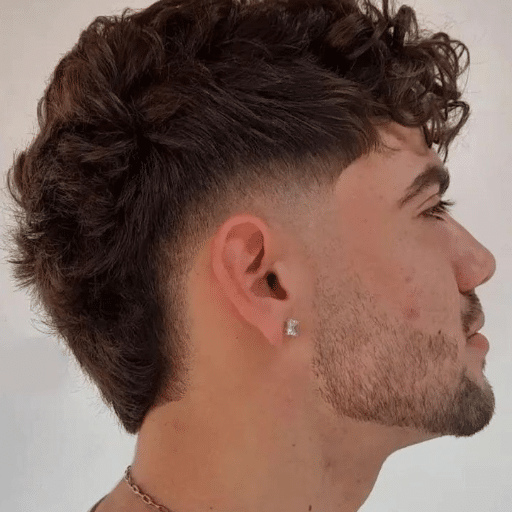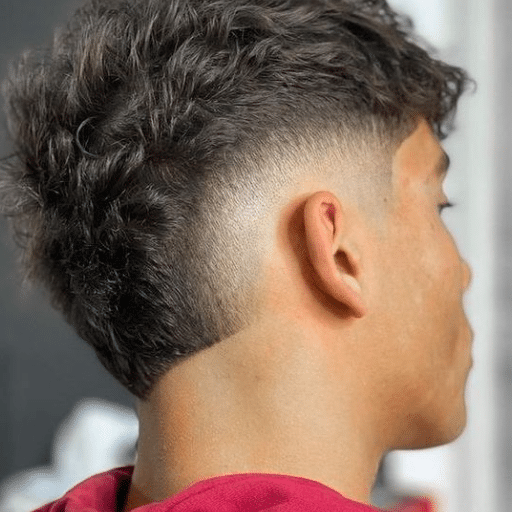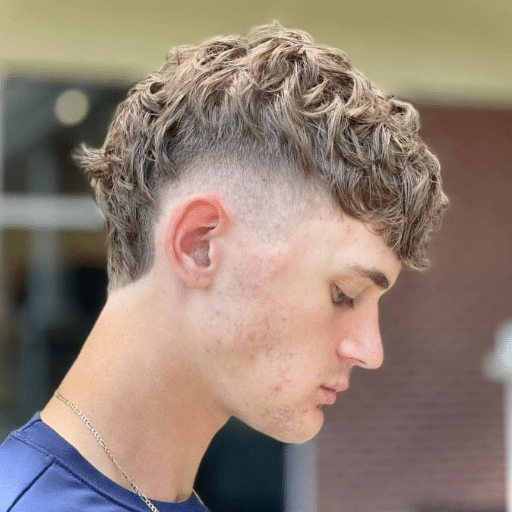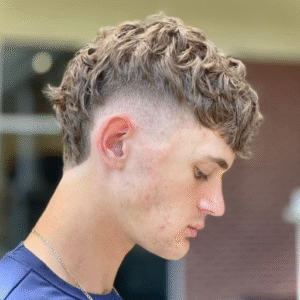The mullet fade is a contemporary style that brings together the old-school mullet with the current trend of fades. It incorporates the bold shape of a mullet with a sharp, modern fade. In this guide, we aim to cover all the components needed for achieving a perfect mullet fade as well as different variations for different textures and lengths. This post includes all fundamental tricks as well as essential styling advice needed to accomplish the desired look. Every professional barber who aims to refine their skills and every individual who wants to sport this striking hairstyle will find all the required knowledge to perfect their mullet fade within this guide.
What is a mullet and how did it become popular?

A mullet is a hairstyle where the front and sides are cut shorter, and the back is longer. It became widely popular in the 1980s along with rock musicians, athletes, and other pop culture figures from that era. The appealing thing about a mullet was that it offered a mixture of a ponytail and a business haircut. Over time, it lost its popularity, but in today’s world, the modern version of a mullet, called a mullet fade has brought the style back to life, thus allowing people to express themselves in unique ways.
History of the mullet hairstyle
In ancient cultures, hairstyles resembling mullets can be traced back centuries. Some historians point out that mullet-like styles were worn by Greek soldiers and Assyrian warriors. They had long hair at the back for warmth and shorter hair at the front for better visibility during battles. Much later in the 1990s, “mullet” became a household term after The Beastie Boys released their hit song “Mullet Head.” By the 1980s, it was widely associated as a sign of boldness and extraordinary individuality and culture, a status it continues to have even today.
The resurgence of the mullet in modern hairstyles
The modern resurgence of the mullet can be observed through a mix of nostalgia and new trends in the fashion world. Thinking outside the box and embracing fresh ideas is sought after in society today, which is why the mullet has gained so much popularity. It offers timeless versatility while being effortlessly edgy. Blunt and textured cuts, along with blended transitions, are now being incorporated worldwide into stylized mullets, which adds to the appeal of sporting this hairstyle. For self-expression, to embrace its rich past or simply appeal to modernized taste, the pop culture sociologists claim that the re-emergence of the mullet is a testimony to the cyclical phenomenon of fashion and nostalgia.
Iconic mullet haircuts for men through the decades
Reflections of the cultural and social movements of mullet hairstyle’s popularization give it character depth. Let’s review some of the decades defining variations as:
Classic mullet – 1970s: One of the defining features of rockstars such as Bowie, the 70s version was flamboyant and soggy with Shaggy, rough around the edges layers. Mid-length hair with volume to boot, bang on half trimmed and kept feathery – Quite a fashion statement back in the day if you ask me.
1980s Power Mullet: In the 1980s, the mullet became a big hit when people such as Billy Ray Cyrus were sporting it. It was bold and attention-grabbing with a big flowing back tail showcasing defiance and some parts being heavily layered, rebellious and confident.
1990s Subtle Mullet: This decade toned down the boldness of the mullet and made it more subtle. The aggressive and rough cuts by Andre Agassi also adopt the essence of a polished mullet, but with far less attitude.
2000s Retro Resurgence: There was an odd spurt of subcultures in the early 2000s that made retro even more retro with asymmetrical layers and spikey tops. Even though mullets lost popularity for a while, this bold take added a very odd but eccentric touch.
2020s Modern Mullet: Celebrities such as Miley Cyrus and Chris Hemsworth have fully adopted the modern touches that have been added to the classic mullet with texture, fades, layers, and softer transitions. Today mullets are more embraced as personal statements, which makes them a lot more stylish and accentuated personal hairstyles.
Every interpretation and style of the mullet manifests a different type of beauty, signifying its iconic stature. A hairstyle combines these two factions artfully – simplicity and complexity, speaking volumes to self-expression and individuality.
How to achieve the ideal mullet fade?

Create the perfect mullet fade by first deciding on the fade type: low, mid, or high fade. These options are personal and subjective. Using professional-grade clippers, carefully taper the sides and back to create a smooth transition into the progressively longer hair at the top and back. Cut and blend harsh lines. The back length maintains the signature mullet look, so trim it sparingly to contrast with the faded sides. Keep the faded mullet looking sharp and well-defined with regular trims, styling mullet-specific products like pomade, and texturizing spray.
Choosing the right fade for your hair type
While focusing on the procedure of cutting, I pay attention to the way the fade integrates with the hair’s texture and density. A low fade is beneficial for straight and fine hair as it boosts volume and reduces the thinning look. If the hair is thick or curly, a mid or high fade balances head shape while emphasizing the natural texture. For coarse hair, sharp fades are useful as they add structure and maintain crisp lines. I also make sure to consider a person’s head shape or their style to ensure that the haircut brings balance to the features yet remains in proportion.
Step-by-step guide to styling a fade mullet
To properly style a fade mullet, I make sure the hair is clean and moisturized for better manageability. To achieve the desired contrast, I first use clippers to shape the fade on the sides and back, ensuring that I blend the fade meticulously to avoid any harsh lines. Crown and top are also defined by trimming some volume and texturizing the hair to show motion and volume, which helps emphasize the overall shape. The back length of the mullet is left tapered but still prominent, so that the flow follows the contour of the fade. Lightweight products are used at the end to provide hold and definition while preserving the natural finish of the hair. A sharp look, modern without being overdone, is what I strive for through this technique.
Maintaining your mullet fade over time
Keeping your hair fresh requires adherence to specific appointments; in this case, every two to three weeks for touch-up fades. This will ensure the shape is defined and the style remains sharp. Make sure to wash your hair with a sulfate-free shampoo to prevent dryness and accompany it with a conditioner that is light in texture that provides moisture without weighing the hair down. Trimming the back section of hair that is longer will maintain the length while safeguarding against split ends. To keep a refined appearance, apply a light textured matte product to maintain cut polish without over-styling. Following these steps will reliably keep your preferred mullet fade sharp and agile.
What are the different types of mullet hairstyles for men?

Each of the different male mullet styles has its own appeal. The modern mullet features the back lengthier than the sides and front, which are cut short, while the classic mullet modernized includes more texture on top as well as fades and undercuts, which give it a clean look. Individuals with natural curls can sport the curly mullet, which brings out a lot of bounce and fullness in the back. Another distinct style is shag mullet, which is a blend of different lengths and a more relaxed, messy arrangement of choppy textures. For the more daring look, mohawk mullet takes the regular mullet shape but has a strip of longer hair down the middle, with the sides shaved. All of these styles can be customized to suit various lengths, types of hair, and individual taste, which makes modern grooming for men so simple and easy.
Exploring the classic mullet vs. the modern mullet
While classic and modern mullets share some similarities, their aesthetics and context diverge. The classic mullet, which emerged in the 1970s and 1980s, features distinctly short hair in the front and sides with longer hair in the back, often with little to no blending. This hairstyle was famous for its bold and unapologetic contrasts, which defined the fashion of the time. On the other hand, modern mullets tend to be softer and more polished due to the incorporation of layered texture. Fades, undercuts, and even neon-colored hair are combined with modern, fresh cuts and can be used to highlight the wearer’s individuality, making it suitable for contemporary fashion. It is true that both styles retain the quintessential silhouette of ‘business in the front, party in the back,’ however, modern variations have greater adaptability and more options for personalization.
Understanding the burst fade mullet and its variations
The burst fade mullet is a mullet-style haircut distinguished from others by the fusion of a sharp ear fade and a burst mullet silhouette. Like all mullets, it has longer hair at the back. As with most hairstyles, there is a considerable variation at the individual level, such as high or low fades, incorporation of vivid colors, and even textured layers. The burst fade contours the hairstyle further, improving the look, which gives it a modern and clean style while respecting the historical roots of the mullet. Overall, the balance of options enhances adaptability, making it universal to all hair types and a versatile fit to the style of the person.
How to choose the best mullet for your style
While picking a mullet that fits your style best, your face shape, hair texture, and personal vibe all matter. Having a round face, for instance, means sharper, high-contrast mullets with height on top balanced to your face work best. Softer, layered mullets are best for oblong faces. Take your texture into account as well—curly or wavy hair is best suited to a relaxed, tousled natural mullet, while straight hair tends to look more polished and defined. A mullet’s color also matters—for bold looks, daring colors or striking fades serve a more modern touch, whereas more reserved styles give off a classic vibe. Discuss ideas with your hairstylist since they will know which styles work best for your features while taking your lifestyle and individuality into consideration.
How to style a mullet fade for different hair types?

Effectively styling a mullet fade requires consideration of your specific hair type and texture. If you have wavy hair, a lightweight curl-defining cream will help you with texture while also preserving the shape of the fade. Straight hair can be enhanced using volumizing mousse or styling pomade, which adds definition and structure while ensuring a polished appearance. Coily and curly hair types require hydrating creams as well as leave-in conditioners to preserve moisture, fight against frizz, and shape the hair to accentuate curls. Regular trims alongside the use of a blow-dryer or diffuser can maintain the desired shape of the mullet fade and enhance its appearance. Optimal results are obtained when products tailored to the specific hair type are used.
Tips for curly hair and the curly mullet
In my experience, the first step to managing curly hair and a tidy curly mullet is adequate hydration. Moisturizing shampoos, deep conditioners, and sulfate-free products help maintain the curls and avoid dryness. For styling, I use leave-in conditioners or curl creams, which reduce frizz while defining the curls. To maintain the sharpness of the trims, I regularly schedule mullet maintenance. To uplift volume and definition without messing up the curl pattern, I use a diffuser attachment with my blow-dryer. For optimum results, always choose products that align with your specific curl type.
Styling a wavy hair mullet
To style my wavy hair mullet, I accentuate the texture while keeping the shape of the cut intact. As the first step, I put a lightweight curl cream or mousse on damp hair and encouraged waves by drying it with a diffuser set to low. On non-wash days, refreshing the waves is as simple as spraying with water or a wave mist and gently scrunching. An equally important part of the wavy hair mullet is maintaining the edgy shape with effortless volume through regular trims. With the right products tailored for the waves, definition and manageability become effortless.
Creating volume with thick hair in a mullet hairstyle
Achieving and maintaining volume in a mullet hairstyle requires careful attention to layering hair as well as product selection. I make sure that my stylist cuts layers corresponding to my hair’s thickness so that movement is greatly improved. Volumizing mousses or root-lifting sprays work when I apply them to damp hair prior to blow drying, as they provide additional lift at the roots. When blow drying, I scrunch my hair to further define curls while using a diffuser attachment to avoid frizz and enhance texture. Consistent trims are crucial to achieving a well-balanced weight-to-volume ratio, providing a well-defined.
What are some trendy variations of the mullet fade?

Examples of trendy variations of the mullet fade are the classic and modern versions. The classic retains the bold appeal of longer hair in the back with short sides, which are faded. The modern version is more contemporary, featuring a slow blend of lengths that is a bit more subtle, as well as texturized layers. For those who want something bolder, there is the mohawk-inspired mullet fade, which incorporates an elevated center with a spiked, sharply contrasting back section. Another favored option is the curly style, which strengthens natural curls or waves while the sides remain faded. All variations can be tailored to suit one’s preferences and hair type, making it adaptable and versatile.
The edgy mohawk mullet look
The edgy mohawk mullet look is stylish and a combination of boldness and individuality. Its sharp features define a crest that is spiked and tapered or faded on the sides. The appeal of this look is undeniable, regardless of whether you wish to have a punk version or a neat, polished version that reflects your personality and mood. Nearing the perfect haircut, the mohawk mullet is best for people looking to express themselves without acknowledging the heavy dose of rebellion fused with always trendy fashion, making it easy to wear throughout the years.
Incorporating a quiff mullet into your look
In integrating a quiff mullet to my style, I would pay attention to the blend between the full quiff and the tapered or textured mullet. I would also ensure that the length and layers fit my face, hair type, and grow in a harmonious manner. Taming the quiff while keeping the mullet sharp and defined would require high-quality styling products, a strong-hold pomade or wax, to maintain the shape. Quiffs would require regular trims to keep the style sharp and clean, while bold enough to stand out.
The shaggy mullet for a laid-back style
To accomplish a shaggy mullet with an effortless feel, I would add movement and volumetric texture through layering, focusing on the crown and nape areas to achieve a fluffed and relaxed look. I would select a midpoint style, allowing the ends of the hair to frame the face while blending the back to sit nicely. The sides would be tapered slightly for shape, giving a balanced silhouette. Lightweight styling products, such as sea salt spray or matte finishing cream, would work best in providing texture enhancement without weighing the hair down. Routine care includes sporadic trims to maintain this style, preventing split ends, and with the forgiving design, making it low maintenance.
References
-
Maine Campus November 08 2000 – Discusses the cultural significance of hairstyles, including the mullet.
-
Musicians’ hairstyles: a glimpse into the meanings and messages of funk, punk, and rap hair from the 1970s to 1990s in the USA and France – Explores the role of hairstyles like the mullet in music culture.
-
Dordt ends semester with 153 total recorded positive COVID-19 cases – Includes a discussion on the rebellious nature of the mullet hairstyle.
Frequently Asked Questions (FAQ)
Q: What is a mullet fade haircut?
A: A mullet fade haircut is a modern take on the classic mullet where the hair on the sides is gradually faded. It combines elements of a taper fade or skin fade with the traditional mullet style, allowing for various creative versions like the spiky mullet or perm mullet.
Q: How do I ask my barber for a mullet with a fade?
A: When asking for a mullet with a fade, specify the type of fade you want, such as a low taper fade, mid skin fade, or drop fade. Also, mention how you want the length of the hair on top and at the back of the head, whether you prefer a long mullet or a short mullet.
Q: What is the difference between a taper fade and a skin fade?
A: A taper fade gradually shortens the hair, blending it into the skin around the hairline, while a skin fade, or original fade, involves shaving the hair completely down to skin level. Both can be incorporated into a mullet fade haircut.
Q: Can a mullet fade suit curly or wavy hair?
A: Yes, a mullet fade can look great on curly or wavy hair. A permed or wavy mullet can add texture and volume, giving a flowing and dynamic appearance to the haircut.
Q: How can I style a modern mullet haircut?
A: To style a modern mullet haircut, use hair products to add volume or texture to the hair on top and fringe. Whether you have a spiky mullet or a medium mullet, products like mousse or pomade can help achieve the desired look.
Q: What is the best mullet fade for fine hair?
A: For fine hair, a low skin fade or a mullet with a low taper can create an appearance of thickness and texture. Keeping the hair on top slightly longer can also add volume.
Q: How long does it take to grow a mullet fade?
A: The time it takes to grow a mullet fade depends on how long you want the back of the hair and the hair on top. On average, expect a few months to achieve a noticeable look, but regular maintenance is required to keep the fade intact.
Q: Can I incorporate a fringe with a mullet fade?
A: Yes, incorporating a fringe with a mullet fade can add a modern twist to the hairstyle, providing more styling options and helping frame the face.






